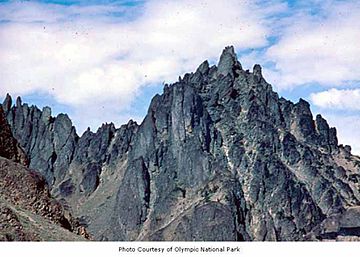Mount Clark (Washington) facts for kids
Quick facts for kids Mount Clark |
|
|---|---|
 |
|
| Highest point | |
| Elevation | 7,528 ft (2,295 m) |
| Prominence | 608 ft (185 m) |
| Geography | |
| Location | Olympic National Park Jefferson County, Washington, US |
| Parent range | Olympic Mountains |
| Topo map | USGS Mount Deception |
| Geology | |
| Age of rock | Eocene |
| Type of rock | basalt |
| Climbing | |
| Easiest route | Scrambling YDS 3 |
Mount Clark is a tall mountain peak in Washington state. It stands about 7,528 feet (2,295 meters) high. You can find it inside Olympic National Park in Jefferson County.
Mount Clark is part of a group of peaks called The Needles. This group is a smaller part of the larger Olympic Mountains. Mount Clark is the second highest peak in The Needles. It is also the seventh highest peak in all of the Olympic Mountains. Other nearby peaks include Mount Johnson and Mount Walkinshaw.
If you want to climb Mount Clark, there are different routes. Some are easier, like scrambling (which means climbing over rocks using your hands and feet). Other routes are much harder, requiring more advanced climbing skills. Water from the mountain flows into streams that lead to the Dungeness River.
Mountain History
The first people to climb Mount Clark reached its top on August 21, 1940. These climbers were George R. Martin and Elvin Johnson. They first called the peak Mt. Belvedere.
The mountain got its official name, Mount Clark, in 1965. It was named to honor Irving M. Clark (1882-1960). He was a Seattle conservationist. A conservationist is someone who works to protect nature. Irving M. Clark was very important in helping to create Olympic National Park.
Weather and Climate
Mount Clark is in a place with a marine west coast climate. This means it's often wet and mild, like many places near the ocean. Most of the weather comes from the Pacific Ocean.
When weather fronts move towards the Olympic Mountains, the mountains force the air to rise. As the air goes up, it cools down. This causes the moisture in the air to turn into rain or snow. This process is called orographic lift. Because of this, the Olympic Mountains get a lot of rain and snow, especially in winter.
In winter, the weather is usually cloudy. But in summer, high-pressure systems over the Pacific Ocean often bring clear skies. The best time to climb Mount Clark is usually from June through September. This is when the weather is most favorable.
Images for kids





